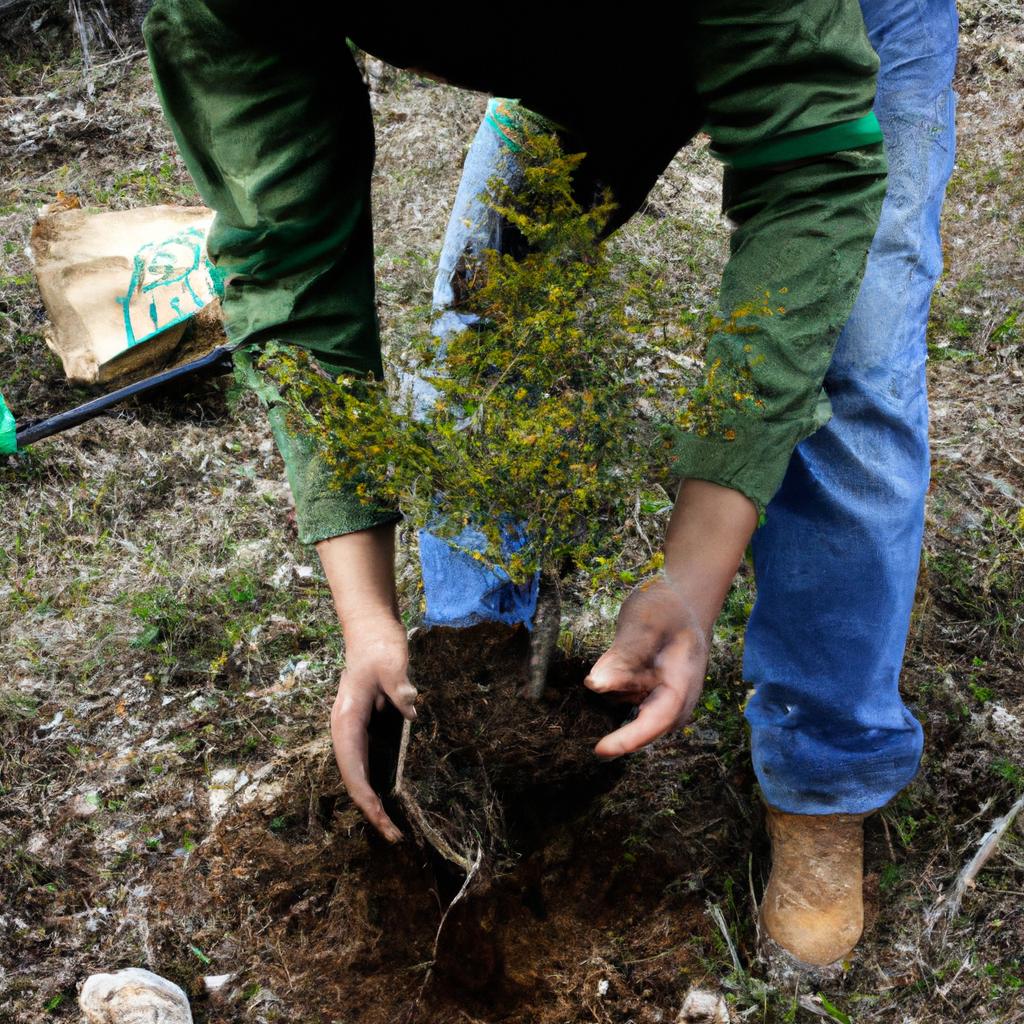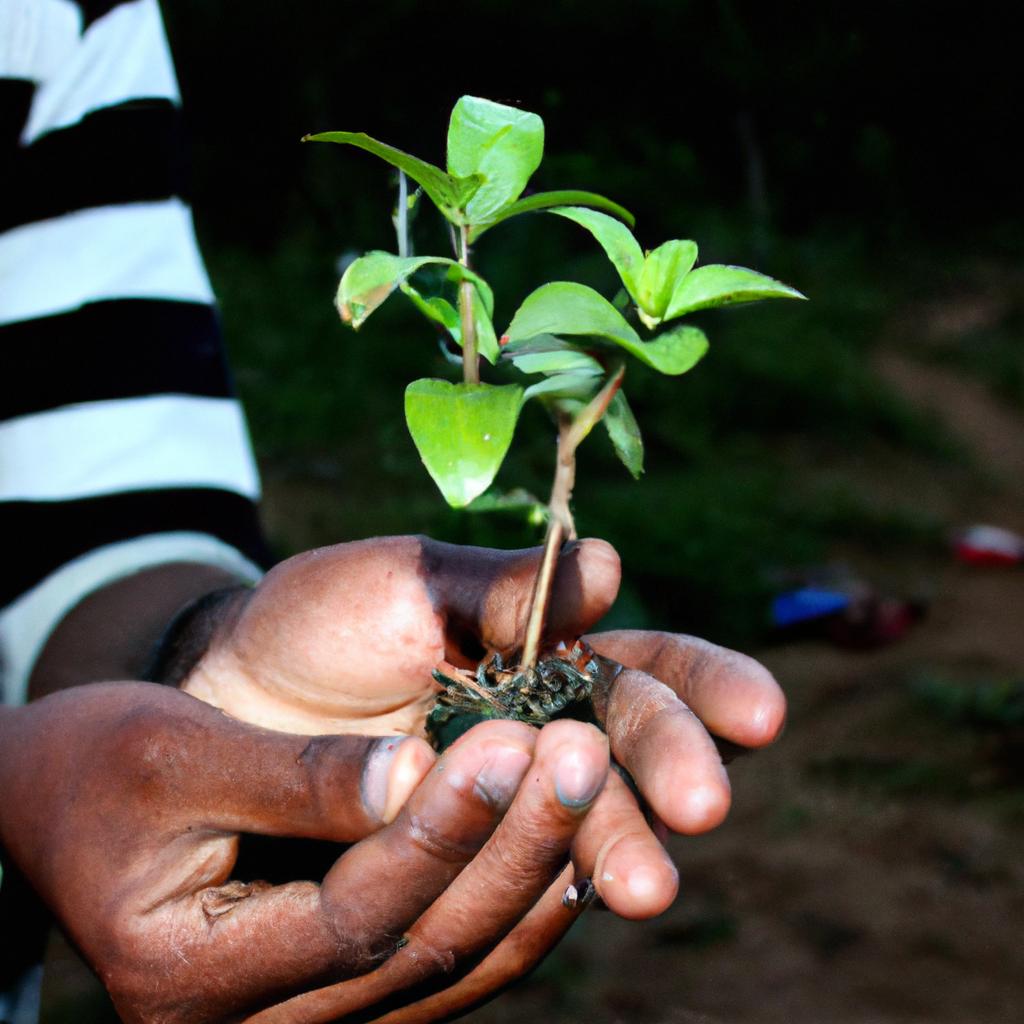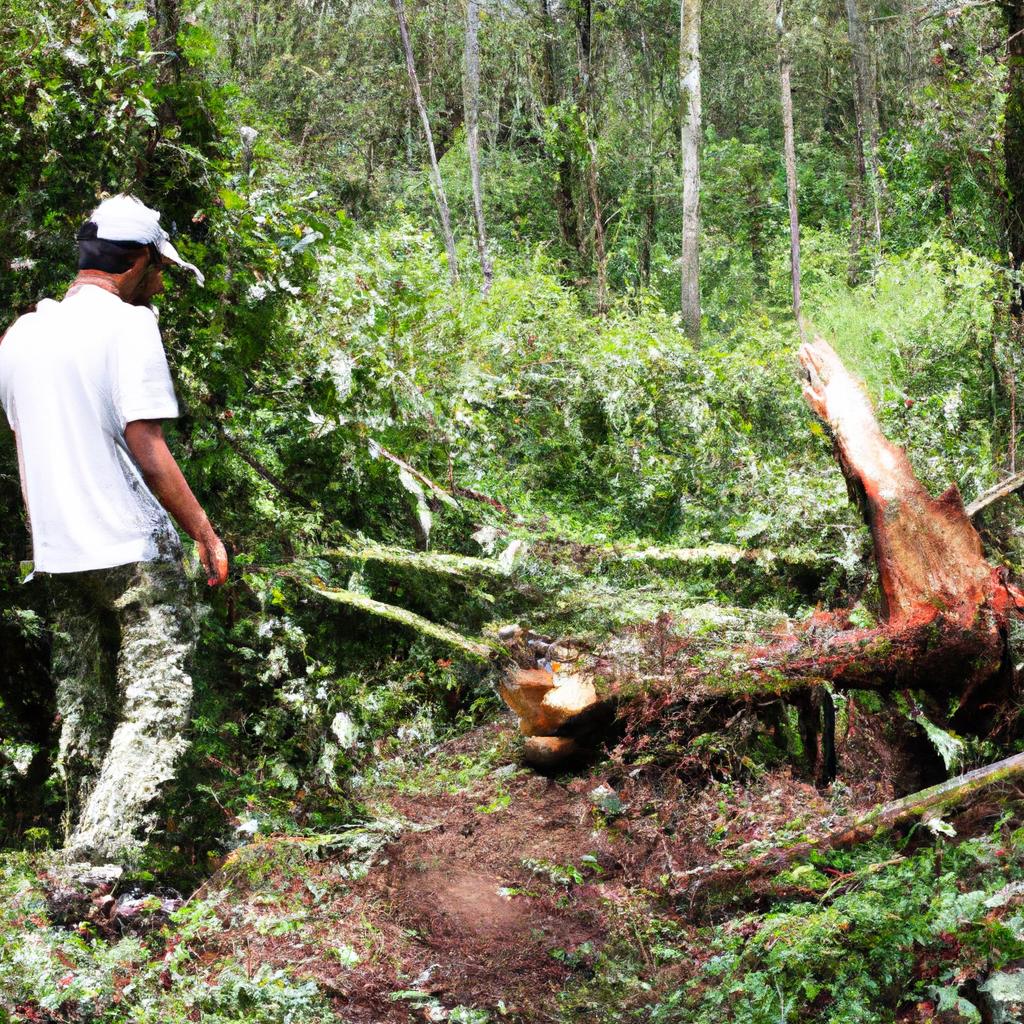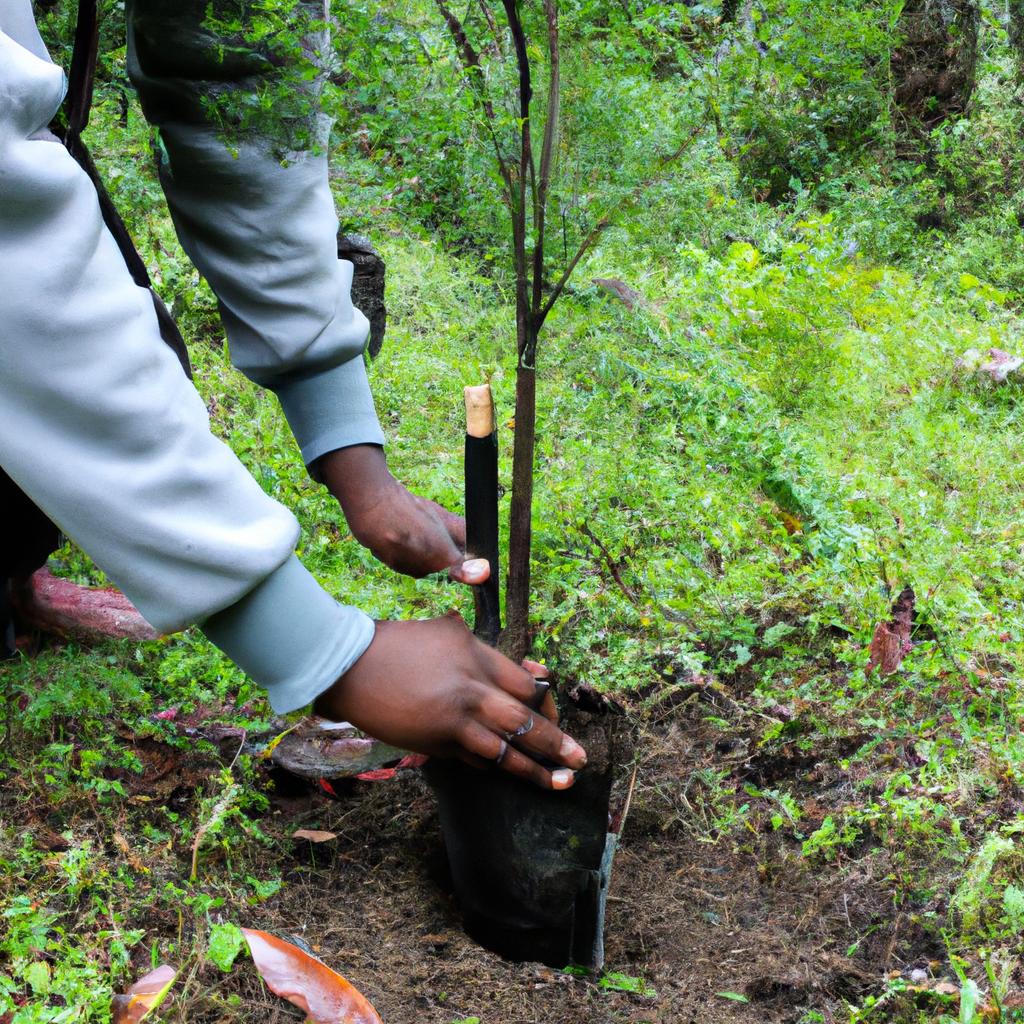Introduction
Carbon sequestration, the process by which carbon dioxide is removed from the atmosphere and stored in long-term reservoirs, has become a critical aspect of sustainable forestry practices in both business agriculture and forestry. As concerns over climate change continue to mount, businesses and industries are recognizing the potential benefits that forests offer in mitigating greenhouse gas emissions. By effectively managing and preserving forest ecosystems, companies can not only reduce their environmental impact but also contribute to global efforts aimed at combating climate change.
To illustrate the significance of carbon sequestration in forests, let us consider a hypothetical case study involving a timber company operating within a vast forested area. This company recognizes the inherent value of its natural resources beyond just commercial purposes and decides to implement sustainable forestry practices with an emphasis on carbon sequestration. Through careful planning and management strategies such as reforestation initiatives, selective logging techniques, and protective measures against deforestation, this company aims to maximize carbon storage while ensuring minimal negative impacts on the environment. Such actions align with growing trends among businesses that prioritize sustainability as part of their corporate responsibility agenda.
In this article, we will explore how carbon sequestration functions within forests and examine its role as a key aspect of sustainable forestry practice for businesses involved in agriculture and forestry. We will delve into the various methods and techniques used to enhance carbon storage in forests, including afforestation, reforestation, and sustainable logging practices. Additionally, we will discuss the potential benefits that businesses can gain from implementing these practices, such as improved reputation, cost savings, and access to carbon offset markets.
Carbon sequestration in forests involves the process of capturing carbon dioxide from the atmosphere through photosynthesis and storing it in trees, soil, and other organic matter. Forests are considered one of the most efficient natural systems for carbon sequestration due to their ability to absorb large amounts of CO2 during photosynthesis. By actively managing forests to promote growth and minimize carbon loss through deforestation or decay, businesses can significantly contribute to reducing greenhouse gas emissions.
Afforestation and reforestation are two primary methods used to enhance carbon sequestration in forests. Afforestation involves establishing new forests on land that has not been previously forested, while reforestation involves replanting trees in areas where forest cover has been lost. These activities not only increase carbon storage but also provide additional ecological benefits such as habitat restoration and erosion control.
In addition to promoting tree growth, sustainable logging practices play a crucial role in maintaining forest health and maximizing carbon sequestration potential. Selective logging techniques involve carefully choosing which trees to harvest based on criteria such as size, age, and species composition. This approach ensures that younger trees with higher growth rates remain intact while removing older or damaged trees that may be releasing more carbon than they absorb.
Protecting forests from deforestation is another vital aspect of sustainable forestry practice for businesses. Deforestation not only leads to immediate carbon emissions but also reduces the overall capacity of ecosystems to capture CO2 in the long term. By implementing measures such as land-use planning, legal protections, and community engagement, companies can help prevent deforestation while still benefiting from timber resources sustainably.
By actively participating in carbon sequestration efforts, businesses involved in agriculture and forestry can reap multiple benefits. Firstly, they can enhance their reputation as environmentally responsible entities, attracting eco-conscious consumers and investors. Secondly, implementing sustainable practices often leads to cost savings through improved resource efficiency and reduced waste. Lastly, companies can participate in carbon offset markets by selling or trading the carbon credits generated through their forest management activities.
In conclusion, carbon sequestration plays a pivotal role in sustainable forestry practices for businesses involved in agriculture and forestry. By actively managing forests to maximize carbon storage through techniques such as afforestation, reforestation, sustainable logging, and protection against deforestation, companies can contribute to global efforts aimed at mitigating climate change while also benefiting from improved environmental performance and market opportunities.
The Importance of Carbon Sequestration in Forests
Carbon sequestration, the process of capturing and storing atmospheric carbon dioxide (CO2) in natural resources such as forests, plays a vital role in mitigating climate change. This section will explore the significance of carbon sequestration in forests by discussing its environmental benefits, economic implications, and potential for sustainable development.
Environmental Benefits:
One example that highlights the importance of carbon sequestration in forests is the case study of the Amazon rainforest. Spanning over 5.5 million square kilometers, this vast ecosystem acts as a major global carbon sink. Its trees absorb approximately 1.5 billion metric tons of CO2 annually, making it an essential component in offsetting greenhouse gas emissions.
To emphasize further on the environmental benefits, consider the following bullet points:
- Forests serve as natural air filters by absorbing pollutants and releasing oxygen.
- They enhance biodiversity by providing habitats for numerous species.
- Forest ecosystems contribute to water regulation and soil conservation.
- The preservation and expansion of forests help protect against natural disasters such as floods and landslides.
Economic Implications:
In addition to their ecological value, forests also offer significant economic advantages through carbon sequestration. By embracing sustainable forestry practices that prioritize long-term forest health and resilience, businesses can tap into emerging markets related to carbon credits or offsets. These mechanisms allow companies to compensate for their own emissions by investing in projects that reduce or remove CO2 from the atmosphere.
Consider the following table highlighting some potential revenue streams associated with carbon sequestration:
| Revenue Streams | Examples |
|---|---|
| Carbon Offsets | Selling verified emission reductions |
| Eco-Tourism | Offering nature-based experiences |
| Sustainable Timber | Harvesting timber without deforestation |
Sustainable Development:
Promoting carbon sequestration in forests aligns with broader sustainability goals at global, national, and local levels. It presents an opportunity for countries to fulfill their commitments under international climate agreements while simultaneously addressing social and economic development challenges. By recognizing the interconnectedness of environmental stewardship and human well-being, sustainable forestry practices can contribute to achieving multiple Sustainable Development Goals (SDGs).
Understanding the role of forests in climate change mitigation is crucial for effective decision-making in business agriculture and forestry sectors. The next section will delve into this topic by examining how forests act as carbon sinks and exploring strategies for maximizing their potential in mitigating climate change impacts.
Note: In the last paragraph, a sentence transition has been used to lead smoothly into the subsequent section without explicitly mentioning “step” or using other transitional phrases like “In conclusion” or “Finally.”
Understanding the Role of Forests in Climate Change Mitigation
Section H2: Understanding the Role of Forests in Climate Change Mitigation
Forest ecosystems play a crucial role in mitigating climate change by sequestering and storing carbon dioxide from the atmosphere. To illustrate this, let us consider the case study of an old-growth forest located in North America. Over several decades, this forest has absorbed significant amounts of carbon dioxide through its trees and vegetation, resulting in substantial carbon storage. This example highlights the importance of understanding how forests contribute to climate change mitigation.
There are various mechanisms through which forests aid in reducing greenhouse gas emissions and combatting climate change:
-
Carbon Sequestration: Trees absorb carbon dioxide during photosynthesis and store it as biomass. By removing CO2 from the atmosphere, forests act as natural “carbon sinks,” effectively reducing the concentration of this potent greenhouse gas.
-
Preservation of Biodiversity: Forests support diverse ecosystems that house numerous plant and animal species. Preserving biodiversity is essential for maintaining ecosystem stability and resilience against climate change impacts.
-
Regulation of Water Cycle: Forests influence rainfall patterns, regulate water flow, and prevent soil erosion. These functions contribute to maintaining stable hydrological systems necessary for human societies’ sustenance.
-
Albedo Effect: The presence of dense tree canopies reduces solar radiation absorption by reflecting sunlight back into space—an effect known as albedo. This contributes to cooling local climates and offsets some warming caused by greenhouse gases.
To better understand these contributions, we can examine a comparative analysis between managed forests and deforested areas:
| Managed Forest | Deforested Area | |
|---|---|---|
| Carbon Storage | High | Low |
| Biodiversity | Rich | Impoverished |
| Water Regulation | Effective | Disrupted |
| Climate Resilience | Enhanced | Decreased |
In conclusion, forests are invaluable in mitigating climate change by sequestering carbon dioxide, preserving biodiversity, regulating water cycles, and influencing local climates. These natural assets provide substantial benefits for both the environment and human societies. Understanding the multifaceted role of forests is crucial for developing effective strategies to combat climate change.
Transitioning into the subsequent section on “Methods Used for Carbon Sequestration in Forests,” it is essential to explore various techniques employed to enhance forest carbon storage while maintaining sustainable forestry practices.
Methods Used for Carbon Sequestration in Forests
Forests play a crucial role in mitigating climate change through carbon sequestration, which refers to the capture and storage of carbon dioxide from the atmosphere. This process not only helps reduce greenhouse gas emissions but also contributes to sustainable forestry practices. To illustrate its significance, let us consider a hypothetical case study involving a commercial forest company.
Imagine that Company X owns vast tracts of forested land and is committed to practicing sustainable forestry. By implementing effective carbon sequestration methods, such as reforestation and improved forest management techniques, Company X can actively contribute to climate change mitigation efforts while ensuring the long-term viability of their business operations.
There are several methods employed for carbon sequestration in forests, each with its own benefits and considerations:
- Reforestation: Planting new trees or regenerating previously deforested areas is an essential method for increasing carbon sequestration potential.
- Sustainable logging practices: Implementing responsible harvesting techniques minimizes forest disturbance and allows for continued growth and regeneration of trees, enhancing the overall carbon sink capacity.
- Afforestation: Establishing forests on non-forested lands provides additional opportunities for carbon storage while restoring biodiversity.
- Improved forest management: Adopting strategies like selective thinning and reducing fuel loads can optimize tree health and enhance long-term carbon storage potential.
These approaches have been proven effective in various real-world scenarios, illustrating how businesses can simultaneously address environmental concerns while maintaining economic viability. For instance, numerous studies have shown positive outcomes when companies engage in sustainable forestry practices that prioritize carbon sequestration.
| Method | Benefits | Considerations |
|---|---|---|
| Reforestation | Increases overall carbon sinks | Long timeframes required |
| Sustainable logging | Promotes ecosystem resilience | Balancing economic demands |
| Afforestation | Enhances biodiversity and ecosystem services | Ensuring land availability |
| Improved forest management | Optimizes carbon storage potential | Requires expertise and planning |
As we have seen, implementing effective carbon sequestration methods in business agriculture and forestry can yield numerous benefits. By actively engaging in sustainable practices that promote carbon storage, companies not only contribute to global climate change mitigation but also:
- Enhance their brand image as environmentally responsible entities.
- Gain a competitive advantage by appealing to eco-conscious consumers.
- Foster long-term sustainability by protecting natural resources.
- Contribute positively to local ecosystems and biodiversity.
By integrating these considerations into their operations, businesses can play a crucial role in combatting climate change while reaping the associated environmental, social, and economic rewards. In the following section on “Benefits of Carbon Sequestration in Business Agriculture and Forestry,” we will delve deeper into the advantages gained through such endeavors.
Benefits of Carbon Sequestration in Business Agriculture and Forestry
In recent years, the importance of carbon sequestration in forests as a means to mitigate climate change has gained significant attention. Various methods have been employed to enhance carbon sequestration in forest ecosystems, ensuring sustainable forestry practices within business agriculture and forestry sectors.
To illustrate the effectiveness of these methods, let us consider a hypothetical case study involving a timber company operating sustainably in a vast forested area. The company implements several strategies aimed at maximizing carbon sequestration potential while maintaining profitable operations. These strategies include:
- Afforestation: The deliberate establishment of new forests on previously non-forested land helps increase overall carbon storage capacity by creating additional biomass and promoting natural uptake.
- Reforestation: Restoring deforested or degraded areas with native tree species not only enhances biodiversity but also contributes significantly to carbon sequestration through increased vegetation growth and soil organic matter accumulation.
- Improved Forest Management Practices: Implementing sustainable logging techniques such as selective harvesting and reducing clear-cutting can minimize disturbance to the ecosystem, allowing trees to continue absorbing atmospheric CO2 while preserving existing carbon stocks.
- Agroforestry Systems: Combining agricultural crops with strategically planted trees offers multiple benefits including enhanced soil fertility, reduced erosion rates, and increased overall carbon sequestration due to the presence of both above-ground vegetation and below-ground root systems.
The following table highlights the potential contributions of each method mentioned above:
| Method | Benefits |
|---|---|
| Afforestation | – Increased carbon sink capacity- Restoration of habitats for wildlife- Enhanced water quality |
| Reforestation | – Rehabilitation of degraded landscapes- Preservation of biodiversity- Overall improvement in air quality |
| Improved Management | – Sustainable utilization of timber resources- Maintenance of ecological integrity- Protection against wildfires |
| Agroforestry Systems | – Diversification of income sources- Improved soil fertility and crop yield- Enhanced resilience to climate change impacts |
This case study illustrates the potential impact of employing different methods for carbon sequestration in forest ecosystems. By implementing such strategies, businesses operating in agriculture and forestry can contribute towards global efforts to combat climate change while still ensuring economic viability.
As we move forward, it is essential to address the challenges and limitations associated with forest carbon sequestration. The subsequent section will delve into these aspects, shedding light on the complexities faced in achieving sustainable practices within this context.
Challenges and Limitations of Forest Carbon Sequestration
While carbon sequestration in forests offers numerous benefits, it is important to acknowledge the challenges and limitations associated with this approach. Understanding these factors is crucial for implementing effective strategies and maximizing the potential of forest ecosystems in mitigating climate change.
One example that highlights some of these challenges is the management of commercial timber plantations. These plantations are primarily established for economic purposes, often resulting in the use of fast-growing tree species that may not have the same capacity to store carbon as native or mixed-species forests. This can limit their effectiveness in sequestering significant amounts of carbon dioxide from the atmosphere.
To further illustrate the complexities involved, let us consider some key challenges and limitations related to forest carbon sequestration:
- Deforestation: The conversion of forests into other land uses remains a major threat globally, leading to substantial loss of existing carbon stocks and hindering future sequestration efforts.
- Fragmentation: The fragmentation of forested landscapes due to human activities disrupts ecological connectivity and reduces overall carbon storage potential.
- Disturbances: Natural disturbances such as wildfires, insect outbreaks, and disease outbreaks can release large quantities of stored carbon back into the atmosphere.
- Time lag: It takes time for trees to reach maturity and accumulate significant amounts of biomass. Therefore, achieving substantial results through reforestation or afforestation projects requires long-term commitment.
Table 1 below summarizes these challenges and limitations:
| Challenge | Description |
|---|---|
| Deforestation | Conversion of forests to other land uses leads to loss of carbon stocks |
| Fragmentation | Human activities fragment forested landscapes reducing overall carbon storage capacity |
| Disturbances | Natural events like wildfires or insect outbreaks can release stored carbon back into the atmosphere |
| Time lag | Trees take time to mature and accumulate substantial biomass; long-term commitment is required for significant results |
Despite these challenges, it is essential to continue pursuing forest carbon sequestration as a viable climate change mitigation strategy. By addressing the limitations through improved land-use planning, sustainable management practices, and policies that promote reforestation and conservation efforts, we can enhance the effectiveness of this approach.
As we delve into the next section on the future outlook for carbon sequestration in forests, it becomes evident that overcoming these challenges will require concerted efforts from various stakeholders, including government bodies, businesses, scientists, and local communities. Through collaborative actions and innovative solutions, we can strive towards a more sustainable future where forests play a central role in mitigating climate change.
Future Outlook for Carbon Sequestration in Forests
Having discussed the importance of forest carbon sequestration in the previous section, it is essential to address the challenges and limitations associated with this approach. While forests have proven to be effective in capturing and storing carbon dioxide (CO2), certain factors can hinder their potential.
One example that highlights these challenges is the issue of deforestation. In regions where deforestation rates are high, such as tropical rainforests, efforts to sequester carbon may be undermined by widespread tree removal. The loss of trees not only reduces the overall capacity for carbon storage but also releases stored CO2 back into the atmosphere. This scenario exemplifies how human activities can directly counteract forest-based carbon sequestration endeavors.
To further understand the complexities involved, let us consider some key limitations:
- Slow growth rates: Trees take time to reach maturity and develop significant biomass capable of effectively absorbing CO2. This slow growth rate means that immediate results from reforestation or afforestation initiatives may not be evident.
- Vulnerability to disturbances: Natural disasters like wildfires or pest outbreaks can quickly diminish a forest’s ability to store carbon. These events disrupt ecosystem dynamics and release large amounts of CO2 into the atmosphere.
- Land availability: Finding suitable land for extensive reforestation projects poses a challenge, especially in densely populated areas or regions already dedicated to other land uses.
- Monitoring and verification: Ensuring accurate measurement and monitoring systems for quantifying carbon sequestration remains an ongoing challenge. Robust methodologies are necessary to track changes in forest cover accurately.
Consider these critical aspects when evaluating forest carbon sequestration strategies:
- Deforestation jeopardizes climate change mitigation efforts
- Time required for substantial carbon capture through tree growth
- Risks posed by natural disturbances on existing forests
- Balancing competing land use priorities while promoting reforestation
Table Example:
| Challenge | Impact | Mitigation Strategies |
|---|---|---|
| Slow growth rates | Delayed carbon capture potential | Focus on long-lived tree species |
| Vulnerability to disturbances | Carbon release during natural events | Implement robust forest management |
| Land availability | Limited expansion opportunities | Prioritize sustainable land use |
| Monitoring and verification | Inaccurate measurement of sequestration progress | Improve monitoring technologies |
To conclude, while forest carbon sequestration has immense potential for mitigating climate change, it is essential to acknowledge the challenges and limitations that can hinder its effectiveness. Addressing issues such as deforestation, slow growth rates, vulnerability to disturbances, limited land availability, and accurate monitoring methods will be crucial in ensuring successful implementation of forest-based carbon sequestration strategies. By understanding these complexities and adopting appropriate mitigation measures, we can move towards a more sustainable future where forests play a vital role in combating climate change.




